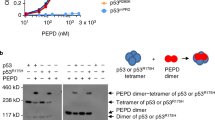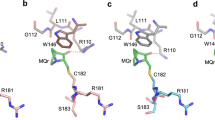Abstract
Activation of the p53 tumor suppressor protein can lead to either cell cycle arrest or apoptosis. Several functional domains necessary for mediating cell cycle arrest and apoptosis in p53 have been mapped, e.g., the proline-rich domain. The proline-rich domain is located within residues 60 – 90, which comprise five PXXP motifs (where P represents proline and X any amino acid). To further delineate the function of the proline-rich domain and its potential role in transactivation, we generated several groups of cell lines that inducibly express various p53 mutants using a tetracycline-regulated expression system. We found that p53(Δ62 – 91), which lacks all five PXXP motifs in human p53, is capable of inducing cell cycle arrest but not apoptosis, while p53(gln22-ser23/Δ62 – 91), which contains a double point mutation in the activation domain as well as deletion of the proline-rich domain, completely loses its activity. However, p53(Δ74 – 91), which contains only one PXXP motif at its N-terminus, is not only capable of inducing cell cycle arrest but also retains a partial apoptotic activity. Furthermore, we found that deletion of the proline-rich region has no or very mild effects on activation of several transiently transfected p53 target gene promoters, i.e., the p21, MDM2, BAX, and GADD45 promoters. However, such deletion differentially affects p53 induction of endogenous target genes, i.e., induction of p21, MDM2, BTG2, p85, PIG3, PIG6 and PIG11 was reduced or abrogated but induction of BAX, KILLER/DR5, PIG2, PIG7 and PIG8 was not substantially affected. Interestingly, induction of GADD45 was enhanced. These results suggest that the proline-rich region may play a role in chromatin remodeling, which counteracts chromatin-mediated repression for some of the endogenous p53 target genes.
This is a preview of subscription content, access via your institution
Access options
Subscribe to this journal
Receive 50 print issues and online access
$259.00 per year
only $5.18 per issue
Buy this article
- Purchase on Springer Link
- Instant access to full article PDF
Prices may be subject to local taxes which are calculated during checkout




Similar content being viewed by others
References
Agarwal ML, Taylor WR, Chernov MV, Chernova OB and Stark GR. . 1998 J. Biol. Chem. 273: 1–4.
Caelles C, Helmberg A and Karin M. . 1994 Nature 370: 220–223.
Chen X, Ko LJ, Jayaraman L and Prives C. . 1996 Genes Dev. 10: 2438–2451.
el-Deiry WS, Tokino T, Velculescu VE, Levy DB, Parsons R, Trent JM, Lin D, Mercer WE, Kinzler KW and Vogelstein B. . 1993 Cell 75: 817–825.
Gerber AN, Klesert TR, Bergstrom DA and Tapscott SJ. . 1997 Genes Dev. 11: 436–450.
Gottlieb TM and Oren M. . 1996 Biochim. Biophys. Acta 1287: 77–102.
Harper JW, Adami GR, Wei N, Keyomarsi K and Elledge SJ. . 1993 Cell 75: 805–816.
Haupt Y, Rowan S, Shaulian E, Vousden KH and Oren M. . 1995 Genes Dev. 9: 2170–2183.
Kadonga JT. . 1998 Cell 92: 307–313.
Kastan MB, Zhan Q, el-Deiry WS, Carrier F, Jacks T, Walsh WV, Plunkett BS, Vogelstein B and Fornace Jr AJ. . 1992 Cell 71: 587–597.
Ko LJ and Prives C. . 1996 Genes Dev. 10: 1054–1072.
Levine AJ. . 1997 Cell 88: 323–331.
Lin J, Chen J, Elenbaas B and Levine AJ. . 1994 Genes Dev. 8: 1235–1246.
Liu M, Iavarone A and Freedman LP. . 1996 J. Biol. Chem. 271: 31723–31728.
Miyashita T, Krajewski S, Krajewska M, Wang HG, Lin HK, Liebermann DA, Hoffman B and Reed JC. . 1994 Oncogene 9: 1799–1805.
Polyak K, Xia Y, Zweiter JL, Kinzler KW and Vogelstein B. . 1997 Nature 389: 300–305.
Rouault JP, Falette N, Guehenneux F, Guillot C, Rimokh R, Wang Q, Berthet C, Moyret-Lalle C, Savatier P, Pain B, Shaw P, Berger R, Samarut J, Magaud JP, Ozturk M, Samarut C and Puisieux A. . 1996 Nat. Genet. 14: 482–486.
Ruaro EM, Collavin L, Del Sal G, Haffner R, Oren M, Levine AJ and Schneider C. . 1997 Proc. Natl. Acad. Sci. USA 94: 4675–4680.
Sakamuro D, Sabbatini P, White E and Prendergast GC. . 1997 Oncogene 15: 887–898.
Smith CL and Hager GL. . 1997 J. Biol. Chem. 272: 27493–27496.
Sugrue MM, Shin DY, Lee SW and Aaronson SA. . 1997 Proc. Natl. Acad. Sci. USA 94: 9648–9653.
Venot C, Maratrat M, Dureuil C, Conseiller E, Bracco L and Debussche L. . 1998 EMBO J. 17: 4668–4679.
Wagner AJ, Kokontis JM and Hay N. . 1994 Genes Dev. 8: 2817–2830.
Walker KK and Levine AJ. . 1996 Proc. Natl. Acad. Sci. USA 93: 15335–15340.
Wang XW, Vermeulen W, Coursen JD, Gibson M, Lupold SE, Forrester K, Xu G, Elmore L, Yeh H, Hoeijmakers JH and Harris CC. . 1996 Genes Dev. 10: 1219–1232.
Wu GS, Burns TF, McDonald III, ER, Jiang W, Meng R, Krantz ID, Kao G, Gan DD, Zhou JY, Muschel R, Hamilton SR, Spinner NB, Markowitz S, Wu G and el-Deiry WS. . 1997 Nat. Genet. 17: 141–143.
Wu X, Bayle JH, Olson D and Levine AJ. . 1993 Genes Dev. 7: 1126–1132.
Xiong Y, Hannon GJ, Zhang H, Casso D, Kobayashi R and Beach D. . 1993 Nature 366: 701–704.
Yin Y, Terauchi Y, Solomon GG, Aizawa S, Rangarajan PN, Yazaki Y, Kadowaki T and Barrett JC. . 1998 Nature 391: 707–710.
Zhu J, Zhou W, Jiang J and Chen X. . 1998 J. Biol. Chem. 273: 13030–13036.
Acknowledgements
We thank Rhea Markowitz, William Dynan, Mark Anderson, and Pat Schoenlein for critical reading of this manuscript and for helpful discussions and suggestions. This work was supported in part by grants from the United States Department of Defense Army Breast Cancer Program DAMD17-97-I-7019 and the National Institute of Health CA76069.
Author information
Authors and Affiliations
Rights and permissions
About this article
Cite this article
Zhu, J., Jiang, J., Zhou, W. et al. Differential regulation of cellular target genes by p53 devoid of the PXXP motifs with impaired apoptotic activity. Oncogene 18, 2149–2155 (1999). https://doi.org/10.1038/sj.onc.1202533
Received:
Revised:
Accepted:
Published:
Issue Date:
DOI: https://doi.org/10.1038/sj.onc.1202533
Keywords
This article is cited by
-
The proline rich domain of p53 is dispensable for MGMT-dependent DNA repair and cell survival following alkylation damage
Cell Death & Differentiation (2017)
-
p53-mediated apoptosis prevents the accumulation of progenitor B cells and B-cell tumors
Cell Death & Differentiation (2010)
-
PIG11 is Involved in Hepatocellular Carcinogenesis and Its Over-expression Promotes Hepg2 Cell Apoptosis
Pathology & Oncology Research (2009)
-
Possible roles of a tumor suppressor gene PIG11 in hepatocarcinogenesis and As2O3-induced apoptosis in liver cancer cells
Journal of Gastroenterology (2009)
-
The proline-rich domain in p63 is necessary for the transcriptional and apoptosis-inducing activities of TAp63
Oncogene (2008)



